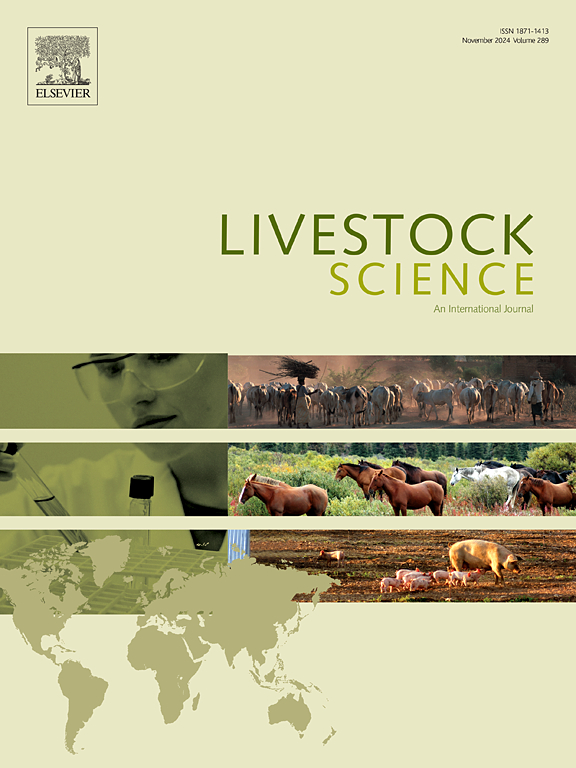The relationship between activity level, litter performance and motion symmetry in adult sows
IF 1.9
3区 农林科学
Q2 AGRICULTURE, DAIRY & ANIMAL SCIENCE
引用次数: 0
Abstract
Lameness and poor limb quality of the sow is, apart from being painful and causing discomfort to the sow, also associated with an increased risk of crushing of piglets. Records of sow activity, as a potential indicator for increased risk of crushing, or increased risk of limb problems, were studied. Records of activity were collected using accelerometers attached to a collar around the neck of the sow. Data was collected on 63 sows at Research centre Lövsta, Uppsala, before and after farrowing. The accelerometers recorded movements over a period of 2.5 days per recording period. Sows were housed individually in farrowing pens with access to straw. Litter size at birth, number of dead piglet and cause of death was recorded by the staff in the stable. A pressure mat was used to investigate how sow gait was affected before and after farrowing. Differences in sow gait parameters were small before and after farrowing. The results show a significant difference in stride velocity between the left and right forelimbs. Further differences were recorded for the stride length of hind limbs. No significant changes were recorded for the weight load distribution between limbs. Activity levels varied over the day with highest activity during the day and lowest at night and in the early morning. Sows with higher levels of activity had a larger proportion of dead piglets, and high levels of activity in total after farrowing was associated with a higher proportion of crushed piglets. However, sows with higher activity levels during the night before farrowing had a lower proportion of crushed piglets. There was no association between activity levels and signs of lameness. In conclusion, activity may serve as an indicator of risk of piglet mortality, but activity in the farrowing pen does not seem to be a useful indicator of lameness.
成年母猪活动水平、产仔性能与运动对称性的关系
母猪的跛行和肢体质量差,除了会给母猪带来疼痛和不适之外,还会增加压死仔猪的风险。研究了母猪活动记录,作为压伤风险增加或肢体问题风险增加的潜在指标。活动记录是通过连接在母猪脖子上的项圈上的加速度计收集的。研究人员在乌普萨拉研究中心Lövsta收集了63头母猪分娩前后的数据。加速度计在每个记录周期内记录2.5天的运动。母猪被单独饲养在有稻草的产房里。猪舍工作人员记录仔猪出生产仔数、死猪数和死亡原因。采用压力垫法观察母猪产前后步态的变化。母猪分娩前后步态参数差异不大。结果表明,左前肢和右前肢的跨步速度存在显著差异。进一步的差异记录在后肢的步幅上。四肢之间的重量负荷分布没有明显的变化。活动量在一天中变化很大,白天活动量最高,晚上和清晨活动量最低。活动水平越高的母猪死仔猪的比例越大,分娩后总体活动水平越高,仔猪被压碎的比例也越高。然而,在分娩前一晚活动水平较高的母猪,仔猪被压碎的比例较低。运动水平和跛行症状之间没有联系。综上所述,活动可以作为仔猪死亡风险的一个指标,但在分娩栏中的活动似乎并不是跛行的一个有用指标。
本文章由计算机程序翻译,如有差异,请以英文原文为准。
求助全文
约1分钟内获得全文
求助全文
来源期刊

Livestock Science
农林科学-奶制品与动物科学
CiteScore
4.30
自引率
5.60%
发文量
237
审稿时长
3 months
期刊介绍:
Livestock Science promotes the sound development of the livestock sector by publishing original, peer-reviewed research and review articles covering all aspects of this broad field. The journal welcomes submissions on the avant-garde areas of animal genetics, breeding, growth, reproduction, nutrition, physiology, and behaviour in addition to genetic resources, welfare, ethics, health, management and production systems. The high-quality content of this journal reflects the truly international nature of this broad area of research.
 求助内容:
求助内容: 应助结果提醒方式:
应助结果提醒方式:


